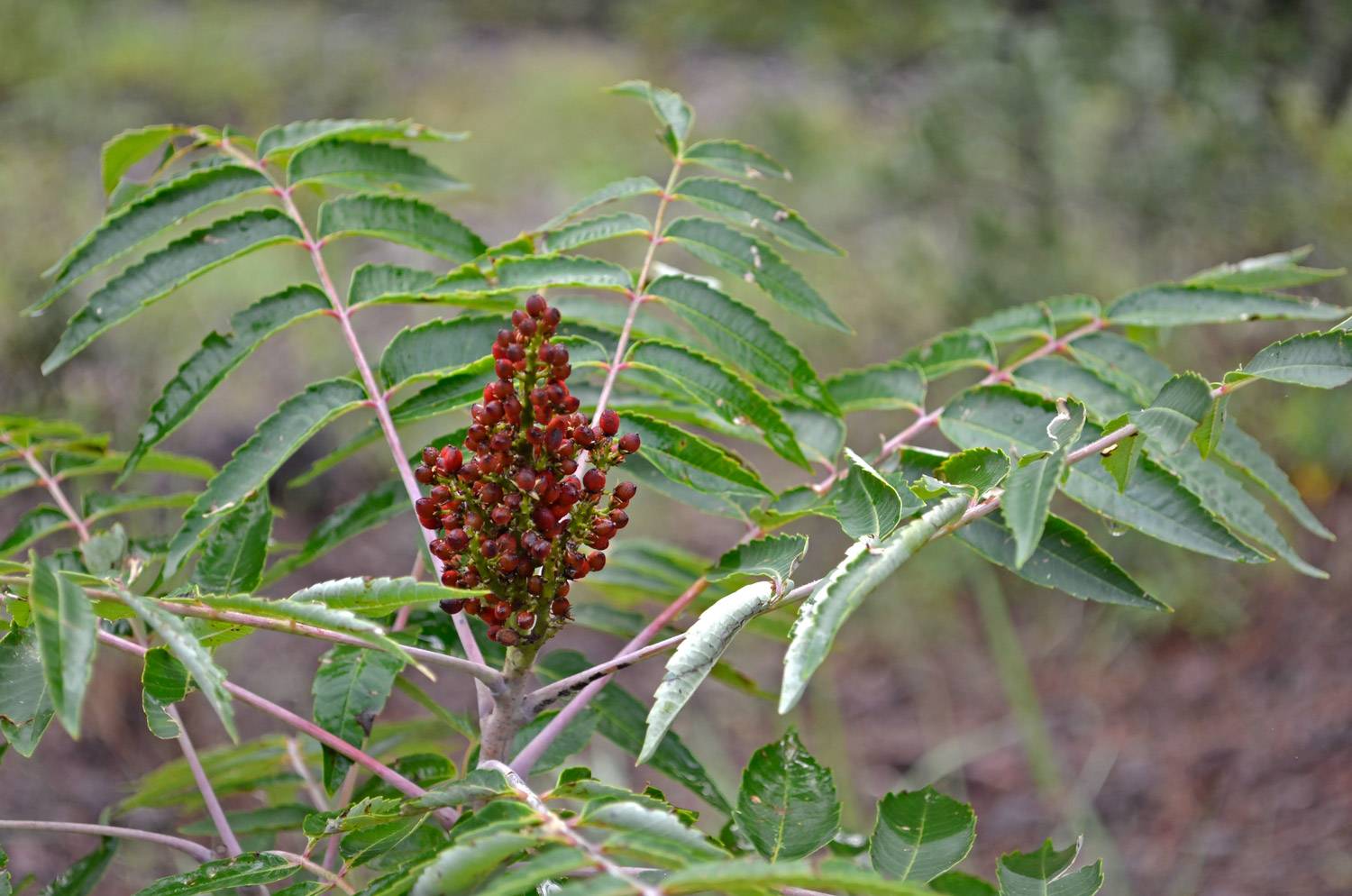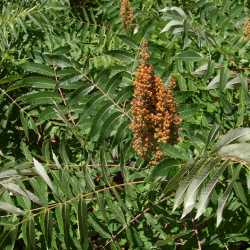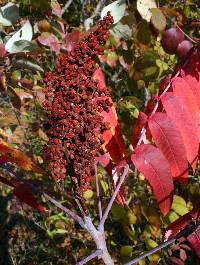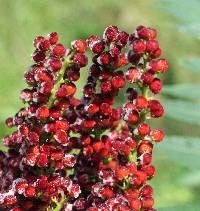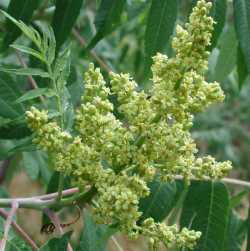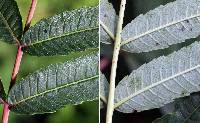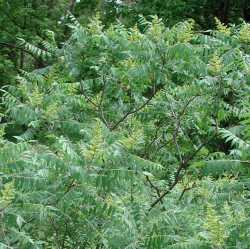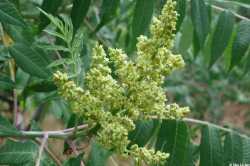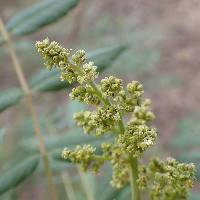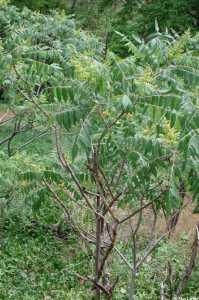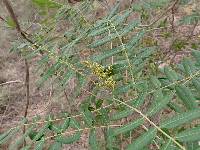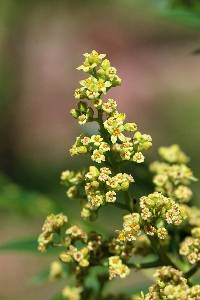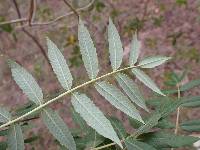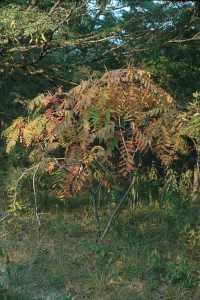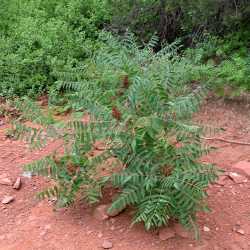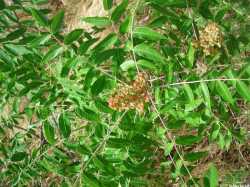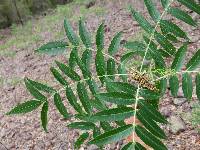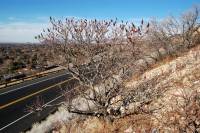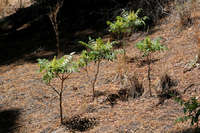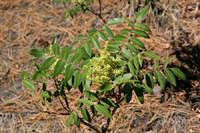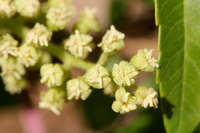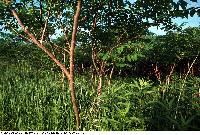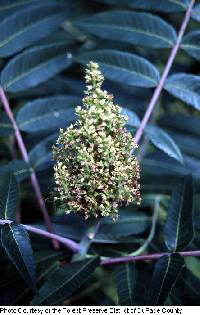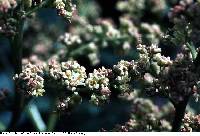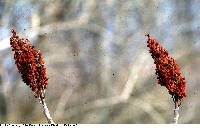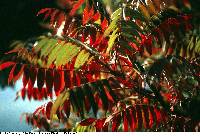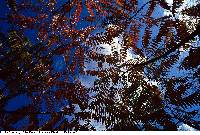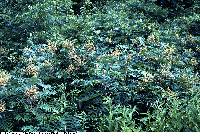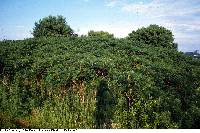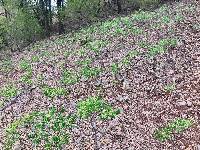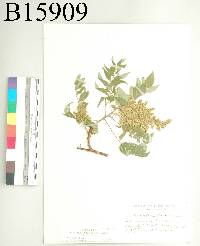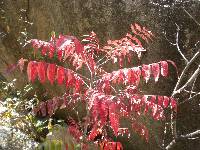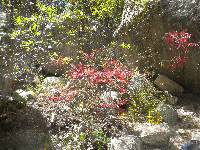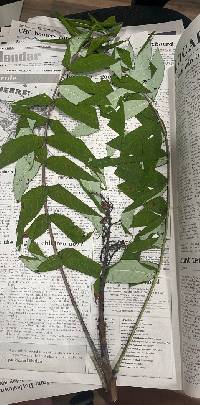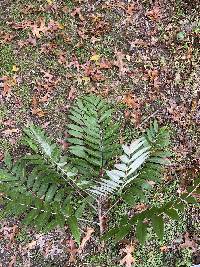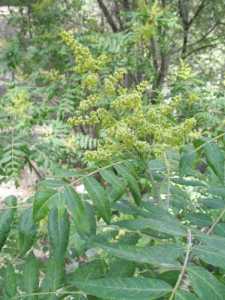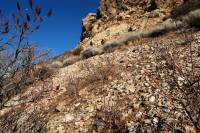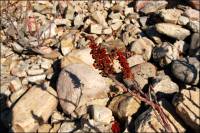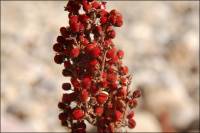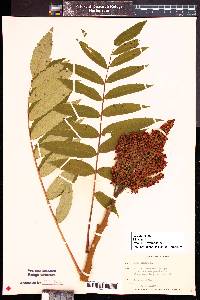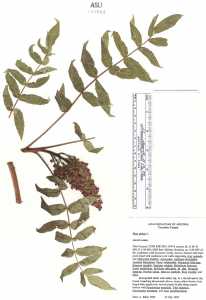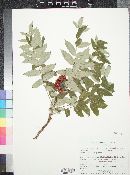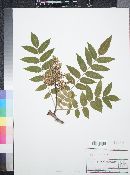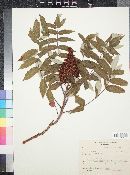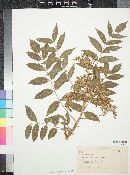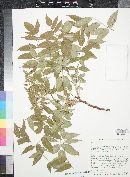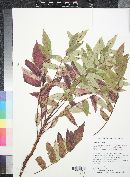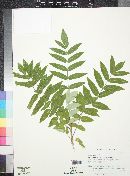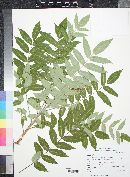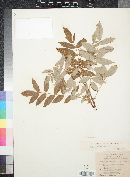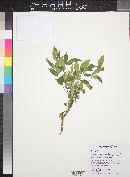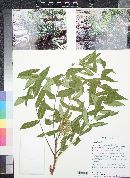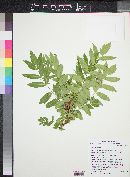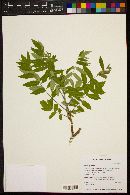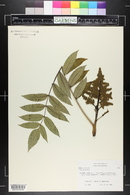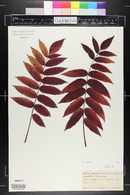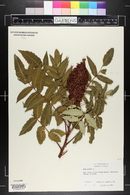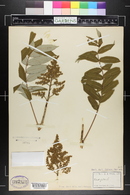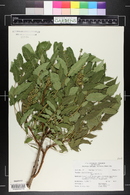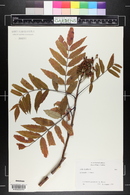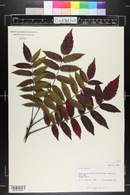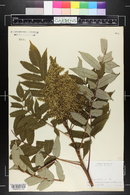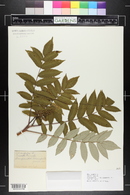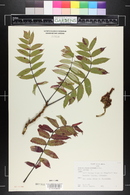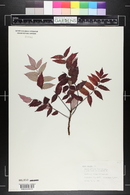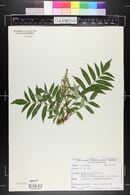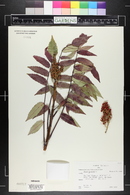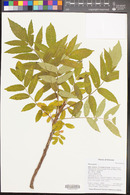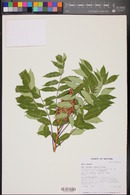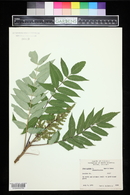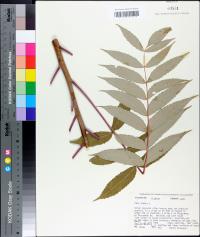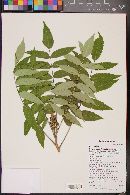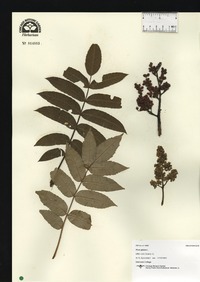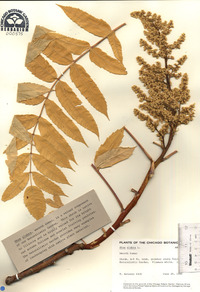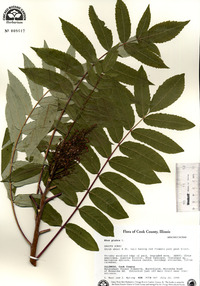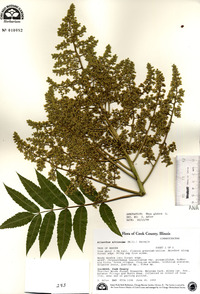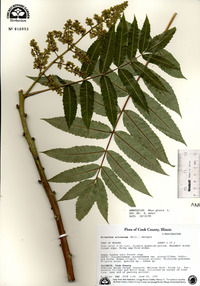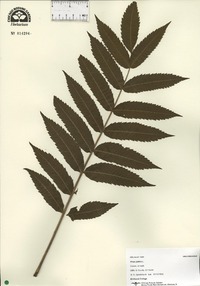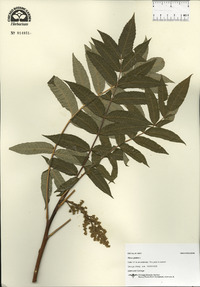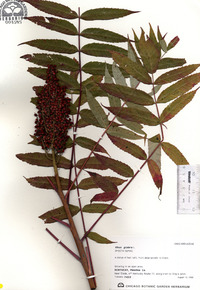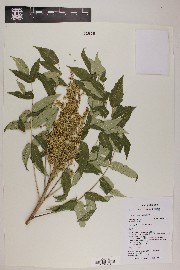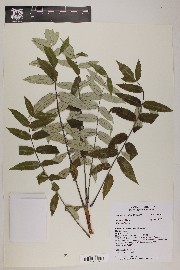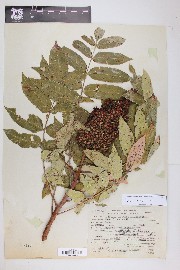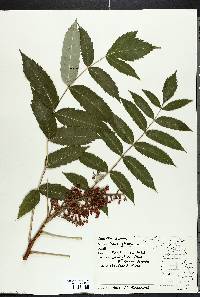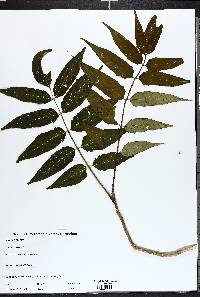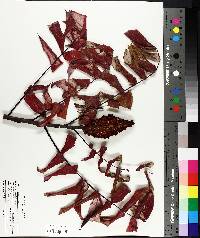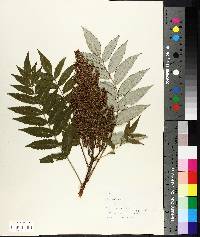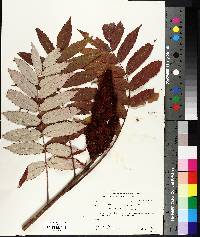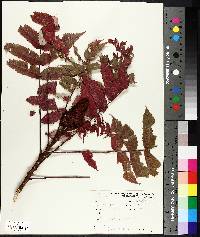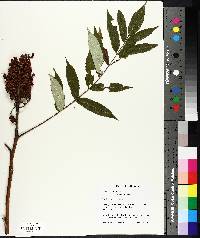
|
|
|
|
Family: Anacardiaceae
Smooth Sumac
[Rhus angustiarum Lunell, moreRhus asplenifolia Greene, Rhus auriculata Greene, Rhus calophylla Greene, Rhus caroliniana Mill., Rhus cismontana , Rhus glabra f. abludens Moldenke, Rhus glabra var. laciniata Carr., Rhus glabra var. occidentalis Torr., Rhus hapemanii Lunell, Rhus laevicaulis Torr. ex A. Gray, Rhus media Greene, Rhus petiolata Greene, Rhus pulchella Greene, Rhus sambucina Greene, Rhus sandbergii Greene, Rhus valida Greene, Schmalzia glabra (L.) Small] |
Usually a sparingly branched shrub, but sometimes to 6 m, vigorously colonial; petioles and younger branches glabrous and somewhat glaucous; lfls 11-31, lanceolate to narrowly oblong, 5-10 cm, acuminate, commonly serrate, much paler beneath; infl terminal, often 2 dm; frs 4-5 mm, somewhat flattened, bright red, densely beset with thick, minute red hairs 0.2 mm. Abundant in upland sites, old fields, roadsides, and margins of woods; N. Engl. and s. Que. to B.C., s. to n. Fla., Tex., and Mex. June, July. Forms with bipinnate lvs occur. A hybrid with no. 2 [Rhus typhina L.] has been called R. آorealis (Britton) Greene. Gleason, Henry A. & Cronquist, Arthur J. 1991. Manual of vascular plants of northeastern United States and adjacent Canada. lxxv + 910 pp. ©The New York Botanical Garden. All rights reserved. Used by permission. Small tree or large shrub to 7 m tall Leaves: alternate, pinnately compound, 20 - 50 cm long, with eleven to 31 leaflets. The stalk is 3 - 10 cm long, hairless or nearly so, enlarged near the base, and encloses the bud. Flowers: either male or female, found on separate plants (dioecious), sometimes with unisexual and bisexual flowers (polygamous). The inflorescence is large (10 - 25 cm long), terminal, and branched (panicle), with a hairless stalk and tiny yellowish green flowers. Fruit: fleshy with a center stone (drupe), borne in dense upright clusters, bright red, 3 - 5 mm across, covered with numerous sticky red hairs less than 0.5 mm long, persisting into winter. Bark: brown to gray, smooth. Twigs: stout, green to reddish, slightly three-sided, hairless, covered in a whitish waxy coating (glaucous), exuding a milky yellowish sap when cut. The horseshoe-shaped leafscar nearly encircles the bud and has three bundle scars. Buds: 5 - 7 mm long, egg-shaped, hairy. The terminal bud is absent. Leaflets: nearly stalkless (terminal leaflet stalk longest), bright green above, paler to nearly white beneath, 5 - 12 cm long (center leaflets longest), 1.5 - 3 cm wide, lance-shaped to oblong with a pointed tip, toothed (sometimes few), hairless or nearly so, covered with a whitish waxy coating (glaucous) beneath. Fall color is a bright orange, red or purple. Form: rounded to flat-topped, forming colonies from root sprouts. Similar species: Rhus typhina is very similar to Rhus glabra but has very hairy twigs and red needle-like hairs (2 mm long or longer) on its fruit. Rhus x pulvinata is a hybrid between R. typhina and R. glabra with intermediate characteristics. It is quite difficult to identify without the fruit, which has both needle-like and club-like hairs. Rhus copallina is also similar, but the leaf stalk is winged between the leaflets. Toxicodendron vernix differs by its non-toothed leaves and white fruit. Flowering: early June to early July Habitat and ecology: Very common along fencerows, roadsides, railroads, borders of woodlands, and in abandoned fields. Rhus glabra is very shade intolerant. It often forms large colonies to suppress competition. Occurence in the Chicago region: native Notes: Following a fire, Rhus glabra sprouts from its roots. It tolerates dry, infertile soils and is often planted along roadsides and in waste places. Due to its high tannic acid content, Rhus glabra was once used for tanning leather. Etymology: Rhus is the Greek name for a species of sumac. Glabra means hairless. Author: The Morton Arboretum PLANT: Thicket-forming shrubs or small trees, to 3 m tall; bark dark gray; twigs glaucous, lenticular, pinkish-gray. LEAVES: odd-pinnately compound, 13-19 foliolate; leaflets sessile, narrowly lanceolate to oblong, 20-80 mm long, 10-25 mm wide, subentire to serrate, glabrous, dark green above, paler beneath, deciduous and bright red in the fall; apex acuminate; base rounded. INFLORESCENCE: INFLORESCENCES dense thryses, 16-24 cm long, 8-24 cm wide, puberulent; bracts narrowly lanceolate, caducous FLOWERS: to 3 mm long; sepals greenish; petals cream. FRUIT: lenticular-orbicular, to 4 mm in diameter, dark red, glandular pubescent, viscid. NOTES: Rich soil in oak and ponderosa pine woodlands, often in canyons and riparian zones: all AZ cos. except La Paz, Santa Cruz, and Yuma; 1030-1820 m (3400-6000 ft); Jun Aug (fruits may persist overwinter); s Canada, WA, OR to New England, s to FL, TX, AZ, n Mex. REFERENCES: John L. Anderson, 2006, Vascular Plants of Arizona: Anacardiaceae. CANOTIA 3 (2): 13-22. Anderson 2007, Kearney and Peebles 1969 Common Name: smooth sumac Duration: Perennial Nativity: Native Lifeform: Tree General: Thicket-forming shrubs or small trees to 3 m tall; bark dark gray; twigs glaucous, lenticular, pinkish-gray; stems below the inflorescences and leaves glabrous or glabrescent. Leaves: Opposite or alternate, odd-pinnately compound with 13-19 leaflets; leaflets sessile, narrowly lanceolate to oblong, 2-10 cm long, 1-2.5 cm wide, with acuminate tips, rounded bases, subentire to conspicuously serrate margins, glabrous, dark green above, paler beneath; deciduous and bright red in the fall. Flowers: Creamy white, numerous in naked terminal inflorescences of dense puberulent thryses 16-24 cm long and 8-24 cm wide; flowers to 3 mm long, with greenish sepals, subtending bracts narrowly lanceolate, caducous. Fruits: Dark red lenticular-orbicular pods, to 4 mm in diameter, surfaces glandular pubescent or viscid. Ecology: Found in rich soils in oak and ponderosa pine woodlands, in canyons and riparian zones, often forming thickets, from 3,500-7,000 ft (1067-2134 m); flowers June-August. Distribution: Widespread throughout the United States; s CAN to n MEX. Notes: This is a highly recognizable deciduous shrub, found in woodlands across North America. Look for large pinnately compund leaves with lanceolate leaflets, and large dense clusters of cream colored flowers at the branch tips, followed by red seed pods. Other woodland species with large pinnate leaves are Ailanthus altissima (can have up to 40 short-petioled leaflets, smells like rotten peanut butter, fruit is pinkish and winged); Juglans major (a large tree, fruit is a walnut, has fuzzy buds at branch tips); and Sapindus saponaria (leaf rachis is winged with leaf tissue, fruit is a red berry, and older bark peels off in rectangles). Ethnobotany: There are an impressive number of traditional medicinal uses, especially for skin ailments, asthma and other respiratory conditions, and as an emetic. Also used ceremonially. Etymology: Rhus is derived from rhous, an ancient Greek name for Sumac, and glabra means smooth or hairless. Synonyms: Rhus cismontana, Rhus borealis, Rhus calophylla, Schmaltzia glabra Toxicodendron glabrum. Editor: LCrumbacher2012, AHazelton 2015 From Flora of Indiana (1940) by Charles C. Deam Infrequent throughout the state, preferring open places in dry, sandy or gravelly soil, or sometimes in moist loam and poor clay soil of hills. It prefers the open and is found along roadsides and fences and in abandoned fields and open woodland. ...... Indiana Coefficient of Conservatism: C = 1 Wetland Indicator Status: N/A Diagnostic Traits: small tree; leaves pinnately compound with 11-31, more or less serrate leaflets; rachis unwinged; branches glabrous; panicle densely ovoid; fruit with minute, appressed hairs. |
|
|
|

